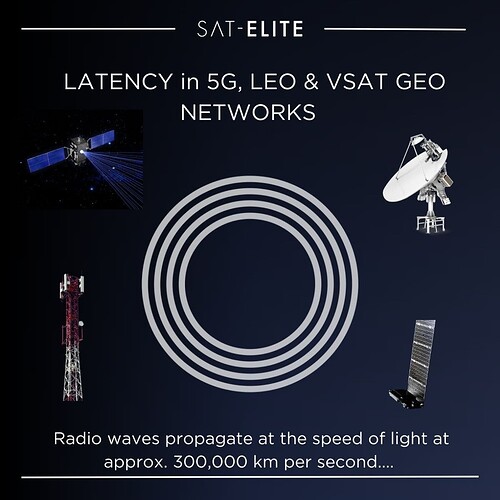What is latency?
Latency is the time it takes for a data packet to travel from the sender to the receiver and back. With data travelling on radio waves propagating at the speed of light, we see why latencies are different among the technologies. Latency (ms) = distance between user and internet hub (km) / speed of light (km). Then multiple all by 1000 to convert from seconds to milliseconds. Here’s a rough estimate of latency calculations for 5G vs LEO vs VSAT:
-
5G: Distance from user to cell tower can be between a couple of hundred metres to 50km. Latency typically ranges from 1-30 milliseconds (ms) depending on the location and network load.
-
LEO: e.g Starlink satellites have a distance of 550km in space. Latency ranges from 25-50ms depending on location on Earth. While LEO satellites can offer higher data throughput, they do have a more extended round trip between the sender and receiver due to the distance from the satellite and how many inter satellite links (ISL) are necessary to reach the ground station.
-
VSAT: Distance from Earth is approx 36,000km Latency typically ranges from 500-700 ms, which is significantly higher than both 5G and LEO.
Note that these values are rough estimates and can vary based on multiple factors such as network load, weather conditions, quality of network infrastructure, and position on Earth.
Applications that require low latency:
-
Online gaming: one of the most latency-sensitive applications, where even a few milliseconds of delay can affect gameplay significantly.
-
Virtual and Augmented Reality: Applications rely on real-time processing and data transfer.
-
Video Conferencing: requires real-time audio and video transmission for an uninterrupted experience.
-
High-Frequency Trading: a financial trading strategy that requires ultra-low latency for automated trades and orders.
-
Remote control: e.g surgical procedures require low latency to ensure that the surgeon can control the instruments in real-time without any lag.
Applications that work fine with a higher latency:
-
File transfer: the bulk of cloud data transfer is not time-sensitive.
-
Email: not critical to receive emails in real-time.
-
Cloud-based applications: rely on a stable and constant network connection, rather than low latency, to ensure stable and continuous data transfer.
-
Streaming: music or video streaming, can operate at higher latency rates as the buffering can account for latency and data propagation.
-
Social media: minor delay times have minimal effects on overall user experience.
Credits: ![]()
